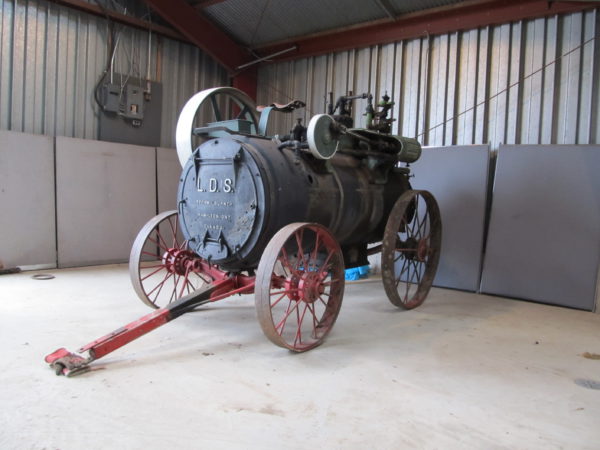
This portable steam engine was produced by the L. D. Sawyer Company of Hamilton, Ontario. The L. D. Sawyer Company was an early Canadian manufacturer of farm machinery such as threshing machines, tread mills, horsepowers and grain drills. As well, L. D. Sawyer sold farm machinery from US manufacturers such as the Pitts threshing machine, the Rochester cutting box, the Ohio reaper, Woods mower and Birdsell clover huller.
In the 1880s L. D. Sawyer began producing a simple portable steam engine for use in powering threshing machines and other equipment. An LDS produced 13 horsepower on the belt. L. D. Sawyer portable engines were quite successful and built in relatively large numbers for a steam engine. With improvements, it remained in the sales catalogue until almost the end of the company’s production of steam engines which occurred in the early 1920s.
This engine came from the MacMurachy family of McConnell, Manitoba. This family purchased the engine in 1886 and used it for many years to power a threshing machine. It was also used to power feed grinders, buzz saws and any other machinery needing belt power. Joe MacMurachy donated the engine in the late 1950s to the Museum.
Joe MacMurachy related that during World War 2, he drove off two scrap men who had driven on to his property and were preparing to scrap this little engine without his permission. After making enquiry as to what they were doing and was informed they were there to scrap his engine, he informed the two men of what he thought of them and then picked up an axe laying nearby. At this, the two scrap men fled.
Joe MacMurachy is known as the person who found what became the “Selkirk” variety of wheat. While cutting a crop of wheat in 1930 that was suffering severely from rust, a disease, he stopped for lunch. While eating his lunch he noticed three plump heads of wheat on the table of the binder. As they were not noticeably affected by rust he saved them and planted them year after year until he had enough seed for a small field. In 1935 while a rust outbreak devastated the wheat crop in the area, his small field showed no effects. He supplied seed from this field to the wheat researchers with the Federal Department of Agriculture who used it to develop the “Selkirk’ variety of wheat which was widely sown on the prairies in the 1950s.


